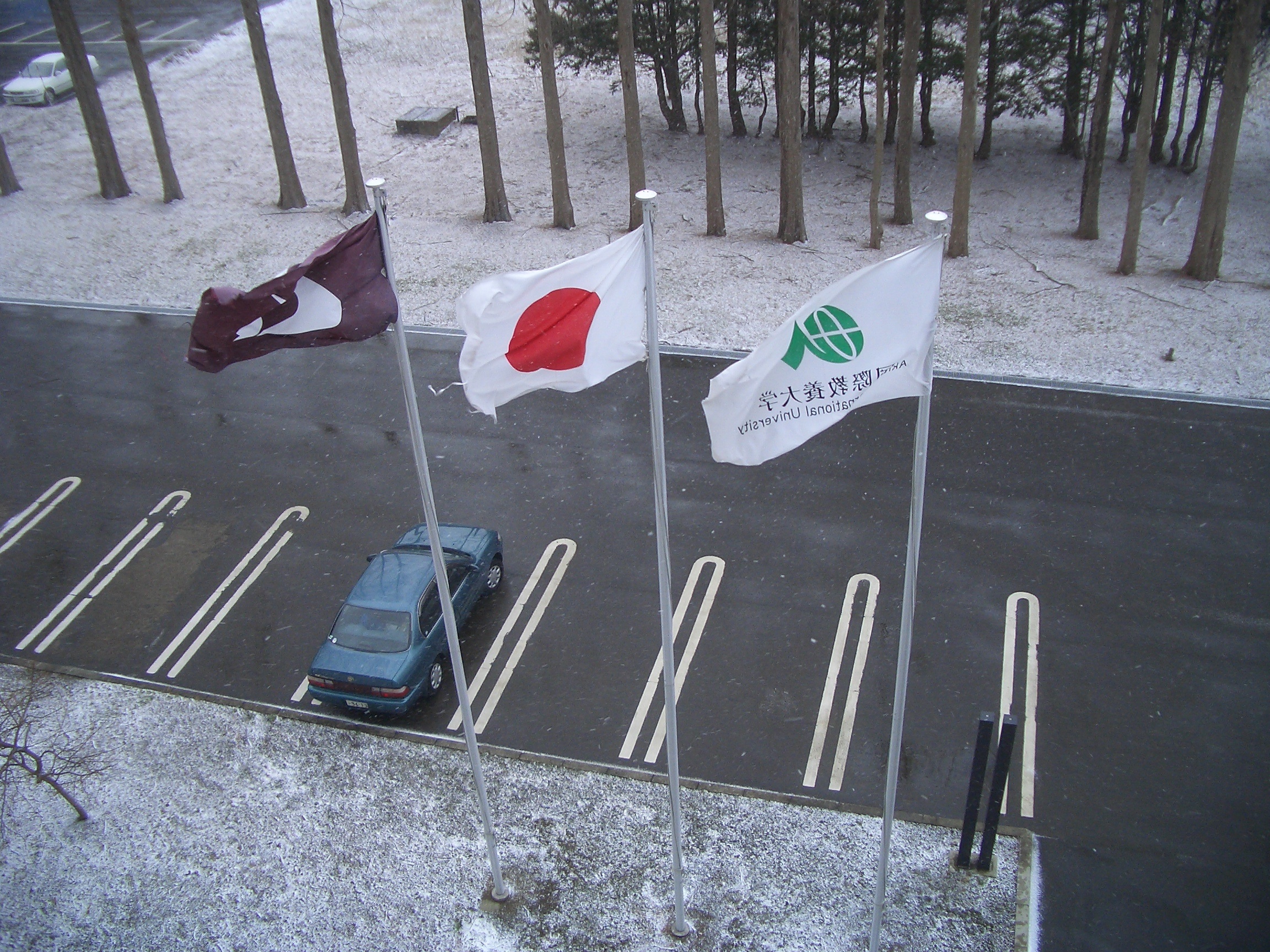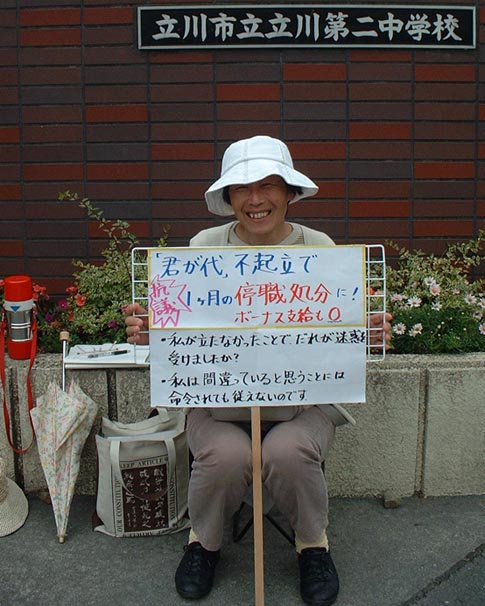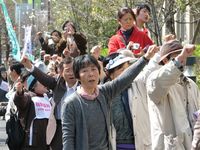John Spiri
In Japan at War: An Oral History, Hideo Sato recalls being forced to hoist the hinomaru, the Japanese flag, in tandem with the playing of Kimigayo — “His Majesty’s Reign,” the Japanese national anthem — as a schoolchild in the 1940s. If the flag reached the top of the pole too early the teachers would beat him. More than 60 years later, he’s “chagrined that they still raise the flag.” [1]
Today, public school teachers in Tokyo are officially punished for refusing to stand when Kimigayo is played at school functions like graduation ceremonies. Nezu Kimiko, a teacher at a Tokyo junior high school, among other punishments, has been suspended without pay for between one and six months every year since 2003 — and 2008’s suspension, if it comes, she says, will be her last.
“This time the board will dismiss me rather than suspend me until June, when I’m scheduled to retire,” Nezu says.
For most of Nezu’s professional life, most schools did not play the Kimigayo or raise the hinomaru. And when schools did hold these patriotic rituals, teachers who dissented by not standing at attention for them were never punished. All that changed in 2004.
“These punishments trace back to right-wing (Tokyo) Mayor Ishihara Shintaro,” says labor activist and filmmaker Matsubara Akira. “Other regions of Japan don’t punish dissenting teachers, or in the rare cases that they do, the punishments don’t become cumulatively more severe.” For Nezu, this simple act of dissent — refusing to stand — has destroyed her teaching career.
“It’s not just the suspensions,” she explains. “For years I’ve been denied the opportunity to be a homeroom teacher. I am severely marginalized at the workplace. Moreover, they transfer me to a different school every year. My commuting time is up to two hours. This is all to punish me.”
It’s not just the Tokyo school board that is punishing Nezu. A number of students — Nezu speculates they are fed propaganda by their parents — are sarcastic or even hostile. Last year it spilled over into violence.
“I was pushed on the stairway by a teenage boy and dropped all my books. It was terrible.”
In addition, Nezu has to live with hate mail and phone calls. Callers and writers tell her to quit teaching. A common taunt is: “Why don’t you go live in North Korea? You’re not Japanese!”
“It can be disheartening to constantly get that sort of message.”
For teachers like Nezu the issue is not about disrespecting Japan or its institutions. Rather, it’s an act of defiance against authoritarian edicts that have, in Japan and elsewhere, led to militarism or war.
Nezu is not the only teacher who has suffered under strict measures taken against dissenting teachers. Some 400 teachers have refused to stand in the past several years, and while many have received reprimands, three have been suspended for repeat offenses: Nezu, Kawarai Junko, a special education teacher, and a female teacher named Watanabe. Fushimi Tadashi, a high school science teacher has suffered various other punishments.
In addition to being reprimanded for not standing in 2003 and 2004, Fushimi received a 10 percent pay cut. Fushimi, like Nezu, gets frequent punitive transfers: he’s teaching at his third school in five years, which is virtually unheard of. The school’s solution to his refusal to stand has been to station him outside to “guard” the gate during school ceremonies. While Fushimi admits feeling some relief because he no longer faces spiraling penalties, he feels pained that colleagues and students inside are being forced to stand.
“As a child I was expected to stand for the Kimigayo and hinomaru, which I did,” he said. “At first I had no idea why. Later, when I learned history and that the Kimigayo was glorifying the emperor, I felt betrayed. I don’t want my students to feel that same betrayal.”
Fushimi, Nezu, and other teachers have also been subjected to “reeducation sessions” (saihatsu boushi kenshu) aimed at “helping” them see the error of their ways. To protest this punishment, Nezu and others came to their sessions wearing clothing emblazoned with messages of dissent and reaffirmation of their opposition to compulsory expressions of patriotism. They received further penalties for wearing such clothing.
Even more vindictive is the action taken against Fujita Katsuhisa, a teacher who distributed fliers before his high school’s graduation ceremony requesting that those who felt uncomfortable with the Kimigayo and hinomaru rituals show their feelings by refusing to stand. The school board took him to court for disorderly conduct for, they claimed, delaying the ceremony for five minutes. The prosecutor demanded that Fujita serve an eight month prison sentence for allegedly causing the delay. Instead, the court ruled Fujita pay a fine of 200,000 yen.
The Tokyo District Court ruled in favor of 400 teacher litigants — up from the 150 instructors who initiated the case — in a suit against the Tokyo School Board On Sept. 21, 2006. The court sided with the plaintiffs on all counts, ruling that: 1) Teachers have no obligation to stand, sing, or play piano at ceremonies; 2) punishments for teachers who do not stand are unacceptable; and 3) the Tokyo Metropolitan Government must pay each plaintiff 30,000 yen in compensation. Moreover, the judge wrote, forcing teachers to stand violates Japan’s Fundamental Law of Education. Undeterred, the Tokyo Board of Education has appealed to the Supreme Court. A decision is not expected until 2010. The school board continues to harass and punish educators who do not bend to the dictates of bureaucrats.
Recently, in a separate case, a group of 12 contract teachers and one clerk who refused to stand won a lawsuit against the Tokyo school board. On Feb. 7, 2008, the Tokyo District Court awarded each litigant approximately 2.1 million yen for their inappropriate dismissal.
Despite the monetary settlement, Matsubara considers the victory only partial.
“On the one hand, the judge ruled that the principal’s decree — that teachers who refused to stand be punished — was ‘rational;’ on the other hand the judge considered the school board’s punishment excessive.” Matsubara is optimistic that the decision will bear fruit for Nezu, who faces possible dismissal, when she has her day in court. A victory could mean the return of years of lost wages for Nezu, but not erasure of the years of humiliation.
In 2006 Matsubara and Sasaki Yumi issued a 90 minute DVD, Against Coercion, subtitled in English, documenting the teachers’ struggles. In particular, the DVD follows Nezu as she cheerfully endures her suspension by sitting outside the school gate in all sorts of weather, as a further act of defiance. There she is seen interacting with students and passersby, informing them of the reason why she is being denied the chance to fulfill her duties as a teacher. In addition, the DVD documents teacher protests, tense confrontations between supporters and bureaucrats, and details of the lawsuits.
Japanese nationalists have been pressuring schools for several years. In August 1999, a law instituting the hinomaru as the official flag of Japan and Kimigayo as the national anthem took effect. That same year, a school principal in Hiroshima, feeling caught between the demands of the school board and teachers who refused to participate in the graduation ceremony’s patriotic rituals, committed suicide.

Nationalist pressures have also been felt in universities, where one faculty member was said to have been disciplined for opposing the Iraq War and the raising of the hinomaru.
Several events have fueled neonationalist determination to instil patriotism in students and punish dissenters. The recent media focus on Japanese citizens abducted by North Korea in the 1970s has stoked public anger and offered nationalists a golden opportunity to push for a militarized and militant Japan.
Ishihara, in a call for economic sanctions against North Korea in 2004, complained: “Japan’s foreign policy is immature; it is always based on humanitarianism.”
The Japanese government supported the invasion of Iraq in 2003, dispatching Self Defense Forces (SDF) to Iraq and maritime SDF to refuel U.S. and allied ships in the Persian Gulf. This provoked debate on the future of Article 9 of the Japanese constitution — the “no war” clause. On this issue, Ishihara said in 2004, “I am wondering who made such a nonsense constitution. I cannot find any historical reasonability in it.”
One of only a few missions that were accomplished on the agenda of conservative ex-Prime Minister Abe Shinzo — who resigned in September 2007 after a scandal-rocked year in office — was revising Japan’s Fundamental Law of Education. Enacted one month before the Japanese Constitution on March 31, 1947, Article One of The Fundamental Law of Education stated:
“Education shall aim at the full development of personality, striving for the rearing of the people, sound in mind and body, who shall love truth and justice, esteem individual value, respect labor and have a deep sense of responsibility, and be imbued with the independent spirit, as builders of peaceful state and society.” [2]
In its place, Abe and his allies passed a bill that demanded schools instill “a love of one’s country” in children. Some critics of the new law saw shades of Japan’s 1890 edict decreeing that children must recite stanzas of patriotic praise before the portrait of the emperor. [3]
In Against Coercion, Ouchi Hirokazu, a professor at Matsuyama University, sees a clear link between the move toward “patriotic education” and militarism.
“The meaning of the patriotism to be incorporated is clear. It is to develop people who will voluntarily follow the government’s orders for war,” he explains. “The imposition of Kimigayo and the hinomaru embodies the worsened education law. Therefore, resistance to Kimigayo is a struggle to refuse war efforts at school, as well as to defend the freedom of thought and conscience.”
In Japan at War, World War II veteran Kobayashi Hiroyasu says, “I wonder what war is. I wonder why we did it. … Young kids worked so hard. Without complaint. It makes me seethe.” [4]
Nezu and other educators of conscience believe they have the answer.
April 1, 2008 update courtesy of Nakano Koichi:
The disciplinary actions of the Tokyo Metropolitan Board of Education against the public school teachers who refuse to stand for Kimigayo in school ceremonies was announced on March 31. The two teachers, Nezu-san and Kawarai-san, who faced the prospect of dismissal, were each given 6-month suspension. For Nezu-san, it’s the second time she has been suspended for 6 months, and
she is also being transferred to yet another school (the board of education has been making the point of “relocating” her almost every year, and each time to a school far and far away from home).
It certainly is a “victory” of a kind, since the two teachers faced the possibility of being fired. The
supporters of Nezu-san and Kawarai-san are rejoicing. see their blog.
For more information about the Against Coercion DVD, contact Matsubara Akira in English or Japanese at [email protected].
Further information is available at an English language support website here. The original directive (in Japanese) of the Board of Education on October 23, 2003 is here .
This article was revised and expanded from an article that originated in The Japan Times. It was posted at Japan Focus on March 18, 2008. Updated April 1, 2008.
John Spiri is an Associate Professor and writer at Tokyo University of Agriculture and Technology.
Notes:
[1] Haruko Taya Cook and Theodore F. Cook. 1992. Japan at War: An Oral History (New York: The New Press) 235-236.
[2] For more on the Fundamental Law of Education, click here.
[3] Adam Lebowitz and David McNeill, “Hammering Down the Educational Nail: Abe Revises the Fundamental law of Education,” Japan Focus.
[4] Cook and Cook, Japan at War, 353.







